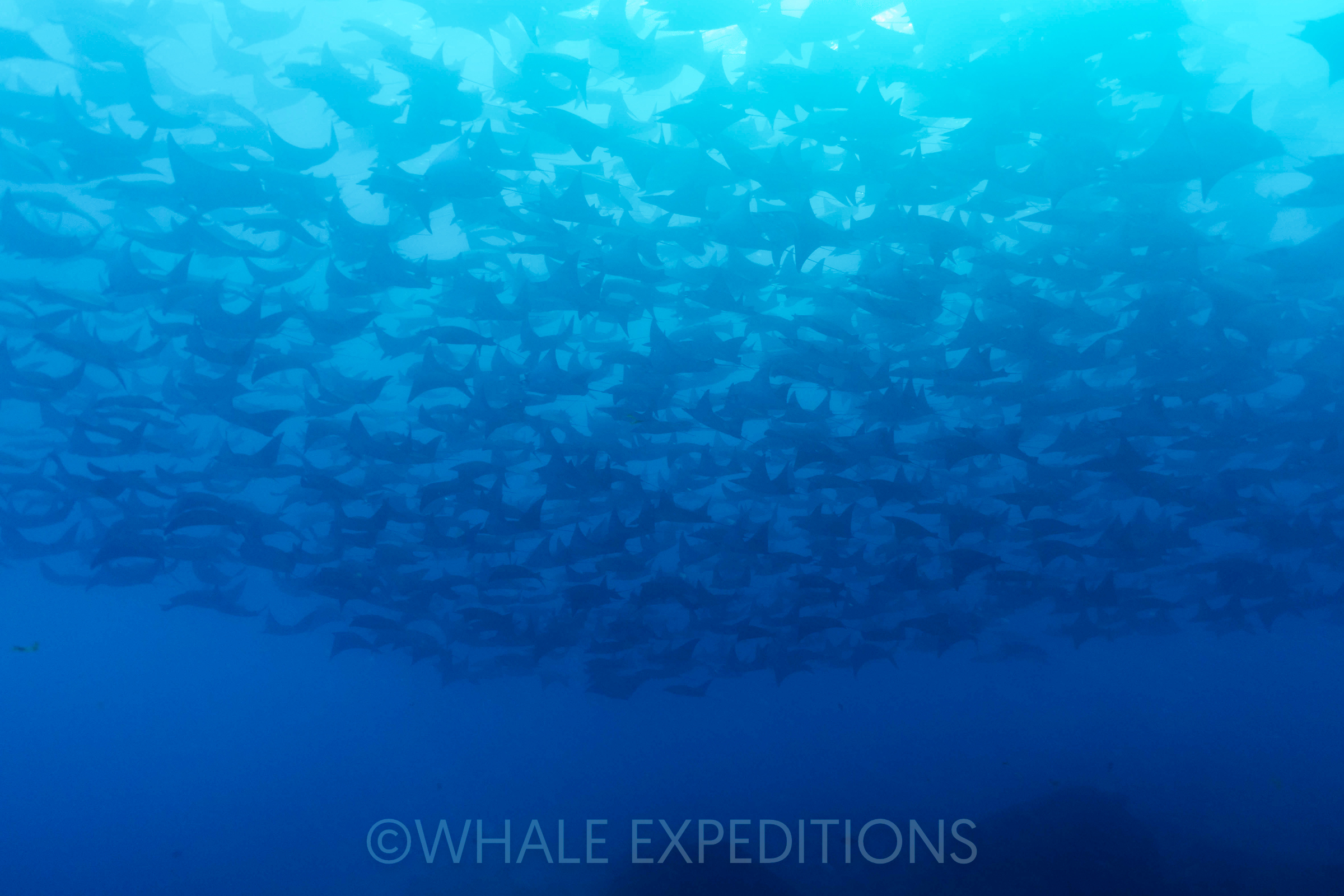Munk's Mobula Ray
MUNK'S MOBULA RAY (Mobula munkiana)
Munk's mobula rays have quite a few common names including Munk's devil ray, pygmy devil ray, smoothtail mobula, and Munk’s pygmy devil ray. They are the smallest mobula ray, with a wingspan of about one meter. But our favorite thing about Munk's mobula rays is the way they aggregate in enormous schools, often in the hundreds or even thousands. Munk's mobula rays can often be spotted from shore leaping out the water and landing in an impressive belly-flop as they hit the surface.
Difficulty: Medium
Munk's Mobula Ray Description
The munk's mobula ray, like all mobula rays has a flattened body, with wing like pectoral fins. Their "wingspan" averages around a meter, with some individuals getting up to 130 cm in width. This makes them the smallest species of mobula ray. They can weigh up to fifty five pounds (25kgs). Their dorsal coloration is brownish to lavendar-gray with a dark black head collar. Their ventral side is white. The munk's mobula ray's tail is shorter than its wingspan, and they do not have a stinger. Like all other mobula rays, munk's mobula rays have fleshy lobes, called cephalic horns, protruding from the front of their heads, enabling them to funnel food into their mouths as they move through the water
Munk's mobula rays have darker ventral coloration with a white underside. Their tail, which does not bear a stinger, is shorter than their body's width.
Munk's Mobula Ray Distribution and Habitat
Munk's mobula rays are found in the coastal waters of the eastern Pacific Ocean from the Sea of Cortez in Mexico, where we hold our orcas and mobula rays of Baja photo tour, to the south in Peru's coastal waters. Their range includes offshore islands like the Galapagos Islands, Cocos Islands, and Malpelo Island. Their are almost always found near the water's surface, generally above fifty feet (15m), though they can dive as low as one hundred feet (30m). Munk's mobula rays migrate, though scientists are unsure of their whole migration pattern, they come into the Sea of Cortez, where we hold our tour, twice a year, in late spring and in the late fall.
Munk's mobula rays migrate into the Sea of Cortez twice a year and congregate around the coastal waters near La Ventana, on the Baja peninsula in Mexico.
Munk's Mobula Ray Feeding Biology
Munk's mobula rays are like other mobula rays in their feeding strategy, they open their mouths as they swim through their microscopic prey. Their cephalic fins, at the front of their head, are bent inwards, funneling their prey into their open mouths. Their prey gets caught on their gill plates, as the water runs through their bodies. This feeding strategy is a type of filter feeding. Munk's mobula rays feed primarily on planktonic crustaceans, but they may also take small schooling fish. When the rays aggregate in huge schools, it may benefit them obtaining their prey more efficiently from the water column.
Munk's Mobula Rays feed exactly like this manta ray. It folds its cephalic fins inwards, opens its mouth, and swims through its planktonic zooplankton prey, catching it on its gill plates.
Munk's Mobula Ray Social Organization
Munk's mobula rays may be found by themselves, in small groups, or in large schools. One of the things that makes our tour so special is that the rays congregate in huge schools, sometimes thousands of individuals strong in the Sea of Cortez. These schools will be made up of both sexes. As almost all other mobula rays, munk's mobula rays often leap out of the water. This, up to two meter high jump, generally ends with a loud, hard bellyflop on the surface. Individual rays will do it, generally in the morning and evening, but in large schools you are likely to see multiple mobula rays do it at the same time. It is still unclear why the rays jump out of the water, but biologists believe it could be to rid themselves of parasites, to court, or simply to play.
Munk's mobula rays can gather in the thousands in the Sea of Cortez during our tour.
Munk's Mobula Ray Reproduction
Munk's mobula rays exhibit aplacental viviparity, which means that eggs are fertilized and hatched inside the mother, but the embryos lack a placental connection to their mother. The ray embryos feed initially on yolk, then receive additional nourishment from the mother by indirect absorption of uterine fluid enriched with mucus, fat or protein through specialized structures. The single young ray is born as a miniature adult, and is free-swimming and feeding. Little else is known about their breeding season, courting rituals, or mating behaviors.
Much of the reproductive biology of Munk's mobula rays is still unknown, except that they exhibit ovoviparity




